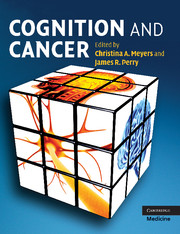Book contents
- Frontmatter
- Contents
- List of contributors
- Preface
- Section 1 Cognition and the brain: measurement, tools, and interpretation
- Section 2 Effects of cancer and cancer treatment on cognition
- 7 Biological bases of radiation injury to the brain
- 8 Cognitive dysfunction related to chemotherapy and biological response modifiers
- 9 Effect of hormones and hormonal treatment on cognition
- 10 Low-grade gliomas
- 11 High-grade gliomas
- 12 Brain metastases
- 13 Primary central nervous system lymphoma
- 14 Childhood brain tumors
- 15 Neurofibromatosis
- 16 Hematological malignancies
- 17 Paraneoplastic disorders
- 18 Symptomatic therapies and supportive care issues
- 19 Animal models and cancer-related symptoms
- Section 3 Interventions and implications for clinical trials
- Index
- Plate section
- References
15 - Neurofibromatosis
Published online by Cambridge University Press: 13 August 2009
- Frontmatter
- Contents
- List of contributors
- Preface
- Section 1 Cognition and the brain: measurement, tools, and interpretation
- Section 2 Effects of cancer and cancer treatment on cognition
- 7 Biological bases of radiation injury to the brain
- 8 Cognitive dysfunction related to chemotherapy and biological response modifiers
- 9 Effect of hormones and hormonal treatment on cognition
- 10 Low-grade gliomas
- 11 High-grade gliomas
- 12 Brain metastases
- 13 Primary central nervous system lymphoma
- 14 Childhood brain tumors
- 15 Neurofibromatosis
- 16 Hematological malignancies
- 17 Paraneoplastic disorders
- 18 Symptomatic therapies and supportive care issues
- 19 Animal models and cancer-related symptoms
- Section 3 Interventions and implications for clinical trials
- Index
- Plate section
- References
Summary
Introduction
History
Neurofibromatosis (NF) is a common neurocutaneous disorder that has an incidence of approximately 1 in 4000 (Mulvihill et al., 1990). Although NF has been postulated to have as many as eight different forms (Riccardi & Eichner, 1986), this classification system has not been widely adopted. Neurofibromatosis is a group of genetic disorders including NF type I (NF-I), NF type II (NF-II), and multiple schwannomatosis, each with distinctly different genetic mutations and pathologic bases. The NF-I gene is nearly ubiquitous in human tissues and so impacts virtually all organ systems. NF-I is particularly interesting to neurocognitive scientists because of its characteristic phenotypical abnormalities in development of form and function in brain. NF-II and multiple schwannomatosis are essentially disorders of cranial nerves, peripheral nerves, and meningeal tissues with no associated cognitive abnormalities and so these disorders will be excluded from this discussion.
The original term neurofibromatosis was derived at the turn of the last century but the disorder is also called von Recklinghausen's disease because the condition was described in the late 1800s clinically and scientifically by Friedrich Daniel von Recklinghausen (Cawthon et al., 1990; Crump, 1981; Viskochil et al., 1990). The molecular genetic basis of distinguishing clinical features of NF-I was localized to chromosome 17 in 1990 by two teams of investigators (Viskochil et al., 1990; Wallace et al., 1990).
- Type
- Chapter
- Information
- Cognition and Cancer , pp. 211 - 227Publisher: Cambridge University PressPrint publication year: 2008
References
- 2
- Cited by



